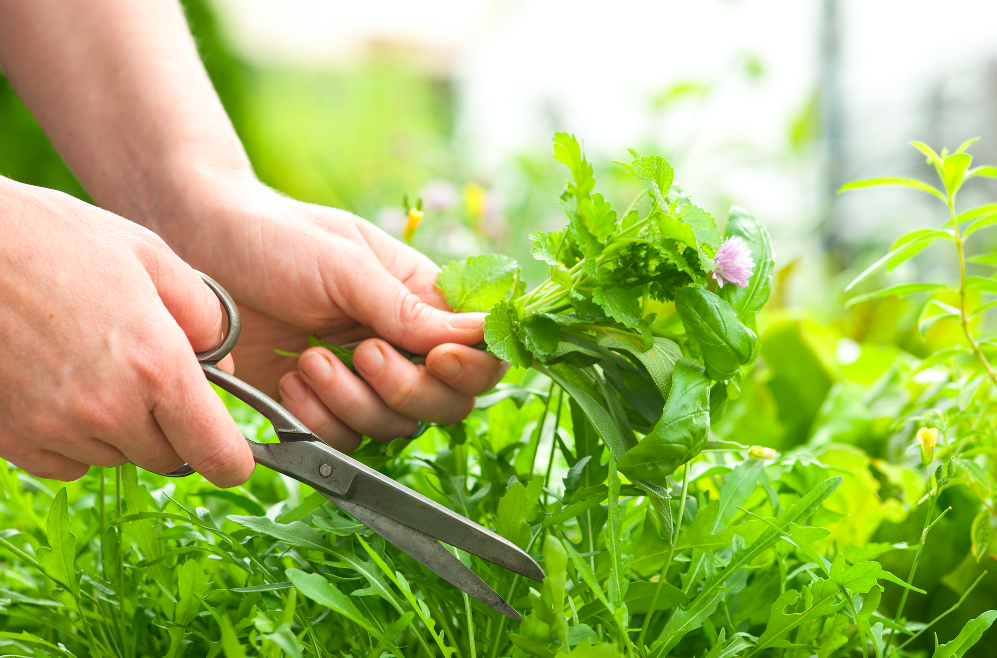In our Spring 2021 issue, our resident gardening expert Hans Wieland offered us a thoughtful piece on recrafting our lawns as places of happiness. We previously published a sneak peek of his piece to our site, but today, we are sharing the whole thing. Enjoy!
Living on the Lawn
A Pledge for a Happy Place
by Hans Wieland
Lawns have always been a controversial and complex topic. “Rasen betreten verboten!” – “Keep off the grass!” – is a running joke about the law and order obeying Germans, but I could easily counter that with the image of big family mansions in the Irish countryside surrounded by two acres of lawn and not a human in sight, sitting or playing on it. What is it with lawns that makes some people obsessed and others depressed? Here is my pledge for lawns as a place of happiness!
Lawns as a status symbol – a very, very short history
Historically, the first lawns were grass fields surrounding English and French castles, old English “launde” meant an “opening in the woods”. Formal lawns became popular with the aristocracy in northern Europe from the Middle Ages onward, when lawns were the perfect status symbol for the nobility.
Keeping huge lawns in shape was very labour intensive. In Blenheim Palace in Oxfordshire fifty people were employed each day to cut the grass and maintain the lawns. This all changed during the Industrial Revolution with the invention of the lawnmower in 1830. A perfectly mowed lawn became the ultimate suburban status symbol for the emerging middle classes, who could afford their own mini versions of wealthy manors, while working class people, living in industrial housing estates, grew vegetables in allotments on public land to supplement their food.
Lawns and Biodiversity
Today, in a world threatened by global warming, the debate about lawns has taken on a new dimension. “To humans, a neatly manicured lawn looks tidy, but without being dramatic, to our wildlife it must look a bit like the apocalypse,” says Dr Úna Fitzpatrick, a senior ecologist with the National Biodiversity Data Centre.
American food writer Michael Pollan describes lawns as emblematic of a “skewed relationship to the land,” adding, “they teach us that, with the help of petrochemicals and technology, we can bend nature to our will.” (In a 1989 article in The New York Times Magazine, “Why Mow? The Case Against Lawns.”)
Lawns and Climate Change
The total estimation of greenhouse gas emission from lawn care, which includes fertilizer and pesticide production, watering, mowing, leaf blowing and other lawn management practices, was found by a University of California-Irvine study *(footnote 1) to be four times greater than the amount of carbon stored by grass. In other words, our lawns produce more CO2 than they absorb.
- Lawns in a pandemic
During the various levels of restrictions, many lawns have – often for the first time – become meeting places, exercise areas, playgrounds and football pitches. Many people have gone even further and turned lawns into gardens during 2020, which is a more productive use of land. If you (still) have a lawn, why not dream big and turn your lawn into a place of happiness? At least sit on it and watch the clouds and listen to the birds.
Imagine what your (too big) lawn could be:
Just imagine what your lawn could be and think what you could buy for the €600- €1000, which is the average that people spend on lawn maintenance per year.
– A small orchard with apples, pears and plums, grown on semi dwarfing rootstock and spaced 4m apart. Start with two-year old trees and go for indigenous varieties.
– A soft fruit area with currants, raspberries, blackberries, gooseberries and strawberries. Once established, there is very little maintenance, except a little pruning and mulching.
– A garden with four raised beds, dimension 5m x 1.20m, with purple potatoes, broad beans, shallots and salad leaves. Grow varieties you cannot buy. A lawn can house a polytunnel.
– A herb garden with culinary and medicinal herbs. Again, once established, there is little maintenance for great returns. And you can add plants each year to your collection. Start with herbs in pots or containers, ideally in a sunny and sheltered spot.
– A mini woodland with one or two big trees (birch or alder), fruiting varieties like elder, rowan, hawthorn, hazelnuts and sea buckthorn.
– Lawns were not always of grass, other possible plants can be camomile and thyme. Lawns in difficult conditions for grasses can become dominated by clovers in dry conditions and moss in damp conditions, let them be. Your wildflower meadow can be just buttercup, ragged robin, bethany, cranesbill and knapweed.
Our law of the lawn
Finally, let me tell you about our lawn. I called it a football pitch or play area years ago, first for our children, and now for our grandchildren. As it was part of a damp field when we bought the cottage, it’s full of dandelion in the spring, has patches of red clover, and lots of plantain, besides the less useful creeping buttercup and a few rushes.
So, it is a foraging area before it becomes a football pitch. The grass clippings from the occasional mowing in the summer are a superb mulch for our raspberry plants and currant bushes. Surrounded on two sides by a native hedgerow, it provides us with hawthorn berries, elderflowers and berries, rose petals and rosehips and rowan berries. Native trees shelter it against the SW winds and provide shade in the summer for our outdoor dining area. It is a lived-in lawn.
Footnote 1: Judy Lowe, January 22, 2010), in a University of California-Irvine study.
Hans Wieland works and teaches at Neantog Kitchen Garden School in Cliffony, Co.Sligo.


